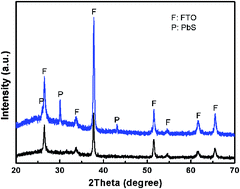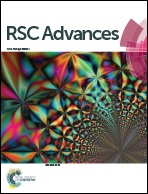High catalytic activity of a PbS counter electrode prepared via chemical bath deposition for quantum dots-sensitized solar cells
Abstract
A PbS counter electrode (CE) has been fabricated by a chemical bath deposition method, and can function as a counter electrode with high catalytic activity for quantum dots-sensitized solar cells (QDSSCs). The PbS nanoparticles can act as an excellent electrical tunnel for fast electron transport from an external circuit to the CE. Electrochemical impedance spectroscopy reveals a low charge transfer resistance (Rct1) between polysulfide and PbS, the optimized PbS CE shows an Rct1 as low as 15.42 Ω cm2. The current density–voltage curves of the QDSSCs were investigated under AM 1.5 light at 100 mW cm−2. CdS quantum dots-sensitized solar cells with the PbS CE achieved a power energy conversion efficiency of 2.91% and showed no obvious degradation of current density over 72 h under ambient conditions.


 Please wait while we load your content...
Please wait while we load your content...